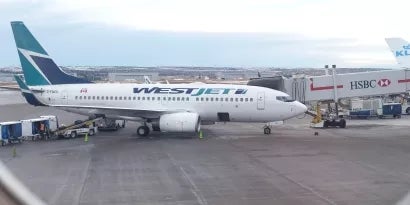
Transportation
Travel & hospitality
Alaska Airlines + UserTesting
Discover how listening to customers and conducting 'beyond device testing' guided Alaska Airlines through the pandemic

UserTesting gives us a distinct competitive advantage. The human insights we uncover empower us to pivot more nimbly and create better customer experiences that consistently land with success in the market. Now, we can do that again and again and again.
Aubri Denevan
Senior UX Researcher, Alaska Airlines

About the company
Headquartered in Seattle, Alaska Airlines is the nation’s fifth-largest airline. The airline flies to more than 115 destinations throughout the United States and North America. It is known for low fares, award-winning customer service and sustainability efforts.
Get started now
Contact Sales Implemented nearly 100 safety-related initiatives based on user insights
Implemented nearly 100 safety-related initiatives based on user insights Awarded the Diamond status in ‘APEX Health Safety’ audit for ensuring the highest standards of cleanliness and sanitation
Awarded the Diamond status in ‘APEX Health Safety’ audit for ensuring the highest standards of cleanliness and sanitation Commitment to customers listening rewarded with increased brand loyalty
Commitment to customers listening rewarded with increased brand loyalty
Alaska Airlines, the nation’s fifth-largest carrier, was not immune to COVID-19’s impact on the travel industry.
Almost overnight, the Seattle-based airline’s passenger count dropped from 130,000 people carried every day to just 4,000.
“It was very scary. We lost $450 million in 30 days,” said retired CEO Brad Tilden in an interview with the Seattle Times. “For 55 days, we had more cancellations than new ticket sales.”
Alaska responded to the crisis with a renewed focus on the customer, and they turned to UserTesting to help. Using a combination of journey mapping and in-airport experience testing, they were able to rapidly innovate and ensure they continued to meet customer expectations in a changing world.
Alaska’s E-commerce Design & Research team has been using UserTesting since 2014. At the pandemic’s onset, they quickly realized that digital touchpoints and messaging were more important than ever as customers wanted to be as safe as possible when traveling.
“We know a lot about our guests and how they travel. But COVID-19 has really changed a lot of the ways we are thinking about travel. We wanted to make sure that we understood the guests’ experience,” said Aubri Denevan, Senior UX Researcher at Alaska.
“We at Alaska have an experience map and we look at the full travel experience from the point when guests first start thinking about traveling all the way till they get to their destination. We have a lot of different phases in that experience map,” she said. “So, we really wanted to look at the holistic view of how COVID-19 is impacting our guests.”
Alaska teams intercepted customers in the airport to understand their mindset as they were waiting for their flights. The insights from destination studies, incorporating guests’ smartphone cameras, enabled Alaska to see and hear what their guests were going through and thinking–in the moment–in their journeys.
They wanted to learn more about four key questions:
What was different about travelers in their preparation prior to going to the airport?
How were passengers spending their time once they go through security and before boarding the airplane?
What new protocols or tactics are our airlines implementing that are creating either a better or perhaps even worse customer experience in the boarding area?
What state of mind were contributors or travelers in and how does this impact their likelihood to travel again during the pandemic?
“The ability to not only get the attitudes from asking people questions but to see, in the moment, what they're seeing and experience with them what they're experiencing, was really, really valuable,” Denevan said.
“We wouldn't have gotten that kind of insight had we not approached it this way and have that 'beyond device testing,' as we call it,” she said. “It was really great to see that, and it was really useful for us.”
Supplementing this qualitative research they received from UserTesting with their own quantitative research, Alaska began to uncover some major themes and see how those themes resonated with their broader audience.
Additionally, the airline did innovative testing using card sorting, prototype design testing, and unmoderated tests to explore the check-in kiosk experience for guests, as well as tested their sales and marketing messages to make sure they were setting the right expectations in advance of customer flights.
“As we put all of that data together, we then look at how can we get these insights that we need? We see there's a problem, but how can we understand more of the why around that?” said Amanda Stockbridge, a product designer at Alaska. “And it's a process to help us identify there are bigger problems, but where can we start and where can we move the needle? And get into more of those user insights that we can get through UserTesting.”
Since the pandemic began, Alaska has implemented nearly 100 actions through all stages of travel aimed at educating and helping guests and employees to stay safe and to build confidence in flying (including creating a safety video that riffs off the 1980s popular song Safety Dance #AlaskaSafetyDance).
Among those initiatives Alaska implemented included:
One of the strictest mask policies in the industry
Blocked middle seats on all flights
A touchless kiosk/app experience for check-in that actually reduces check-in time by several seconds
Partnership with essential oils Alaska Airlines EO to provide hand sanitizing wipes onboard.
Unified messaging across marketing, sales, and preflight to help avoid uncertainties
One of the most flexible change/cancellation policies in the industry
"These advancements help make the travel experience easy and almost entirely touch-free for our guests and are just part of the many ways we're keeping our guests and employees safe during this time," said Charu Jain, senior vice president of merchandising and innovation.
For its efforts, Alaska Airlines has been awarded the Diamond status in the inaugural ‘APEX Health Safety, powered by SimpliFlying’ audit, for efforts in ensuring the highest standards of cleanliness and sanitation.
So much about travel remains outside Alaska’s control. But thanks to intense customer listening with UserTesting and a focus on safety, the airline is optimistic about its future. The ability to observe what customers are experiencing in the moment, and hear them explain out loud what their attitudes and motivations are, makes Alaska's insights immediately actionable.
“I think we are going to have a pretty good summer,” Tilden said. “Right now, it feels like we have a lot of momentum.”
Related customer stories
Get the latest news on events, research, and product launches
By submitting the form, I agree to the Privacy Policy and Terms of Use.






